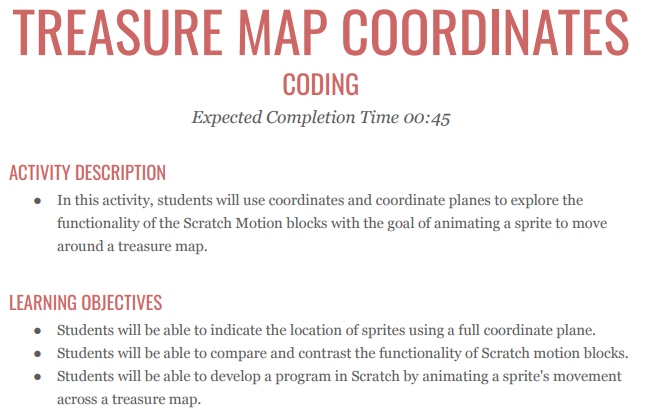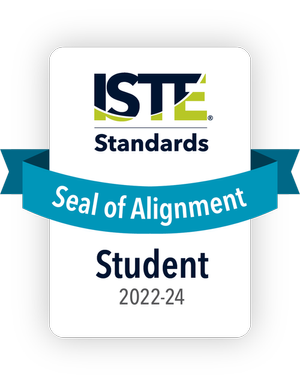Washington DC K-12 Computer Science Standards
Check out this free 3-5 coding lesson to see how Codelicious supports Washington DC’s effort to prioritize computer science education.
Codelicious Computer Science Curriculum
Codelicious Computer Science Curriculum is grade-level differentiated, aligns with all state and national computer science standards, and is continually updated to reflect changes in computer science. Since computer science is more than just coding, Codelicious courses include coding, unplugged, digital citizenship, and STEM career lessons as well as hardware integrations.
Free Computer Science Lesson

TREASURE MAP COORDINATES
In this lesson, students will use coordinates and coordinate planes to explore the functionality of the Scratch Motion blocks with the goal of animating a sprite to move around a treasure map. This lesson is built for grades 3-5 and aligns with computer science elementary standards.
The lesson plan PDF includes links to the appropriate materials and resources, a detailed procedure, activity tips, and a bonus challenge activity.
Washington DC Computer Science Standards
The Washington DC Office of the State Superintendent of Education (OSSE) has yet to require computer science standards for K-12. However, there are initiatives from organizations such as Code.org to increase awareness and education of computer science across the state. According to Code.org Advocacy Coalition, only 45% of public high schools in Washington DC offer a computer science course. The OSSE has outlined suggested computer science standards for schools that want to implement CS instruction. These standards were adapted from the ISTE standards, a national set of K-12 standards for computer science. The standards are described below.
There are 7 areas of the ISTE computer science standards that recur in grades K-12. You can find the ISTE standards pdf here.
-
Empowered Learner – Students leverage technology to take an active role in choosing, achieving and demonstrating competency in their learning goals, informed by the learning sciences.
-
Digital Citizen – Students recognize the rights, responsibilities and opportunities of living, learning and working in an interconnected digital world, and they act and model in ways that are safe, legal and ethical.
-
Knowledge Constructor – Students critically curate a variety of resources using digital tools to construct knowledge, produce creative artifacts and make meaningful learning experiences for themselves and others.
-
Innovative Designer – Students use a variety of technologies within a design process to identify and solve problems by creating new, useful or imaginative solutions.
-
Computational Thinker – Students develop and employ strategies for understanding and solving problems in ways that leverage the power of technological methods to develop and test solutions.
-
Creative Communicator – Students communicate clearly and express themselves creatively for a variety of purposes using the platforms, tools, styles, formats and digital media appropriate to their goals.
-
Global Collaborator – Students use digital tools to broaden their perspectives and enrich their learning by collaborating with others and working effectively in teams locally and globally.
-
Integrating Computer Science
Even though Washington DC does not have common core computer science standards, CS can be integrated into other subject areas – like math, math, ELA, and other branches of science! This integration not only teaches students important skills, but it enhances student learning of all content standards.
One example of integrating computer science with math standards is with this free coding lesson, which involves students using Scratch to interact with the coordinate plane. Additionally, to introduce the concept of algorithms to students, try this free coding lesson that has students working with loops. Algorithms are at the heart of math as well as computer science! Many of our free computer science lesson plans align with math standards.
Likewise, it’s possible to integrate computer science with ELA standards. For example, when assigning a research project during English language arts class, you may want to teach about internet safety before allowing students to explore their research topics on the web. Check out this free lesson about leaving a good digital footprint to incorporate computer science into your classroom.
In our blog Interdisciplinary Connections: Science, we explain how to incorporate computer science instruction into science standards, including physical science, life science, and earth & space science. Another way to integrate computer science is our My STEM Career podcast. In these interviews, we talk with professionals in STEM, and they describe how they use computer science in their daily jobs. Some notable interviews in relation to other branches of science include our episodes with a doctor and an engineering manager. You can also try out this free 3-5 stem career lesson about the aviation field, and then listen to our My STEM Career episode with a pilot.
Finally, to learn more about how computer science works in tandem with other standards, visit our K 12 Computer Science Standards page. Here we highlight how computer science can be taught alongside Common Core Standards, NGSS Science Standards, CSTA Standards, and other national technology standards.
What Is Computer Science Education
The importance of computer science in education is clear as technology continues to advance. According to the Bureau of Labor Statistics, employment in computer and information technology occupations is projected to grow 11% from 2019 to 2029. Given this, shouldn’t we equip our students with these skills starting at a young age?
Currently, computer science programs are serving students as young as kindergarten all the way to high school. Most of these CS courses consist of a coding component, where students learn programming skills. The basic building blocks of coding such as loops, functions, and conditionals can be taught in elementary school and applied to more complex languages as students progress in their K-12 journey. As students attempt more advanced projects, such as developing websites, programs, and games, they are motivated to connect with their world and empowered to expand their skills. To get you started, check out this free coding lesson for grades K-2 that teaches programming skills and aligns with ISTE standards and CSTA standards for students.
Computer science education, however, is not only about coding. Technology standards K-12 also focuses on developing 21st century skills, such as the 4 C’s (communication, collaboration, computational thinking, and creativity). A strong foundation in these computer science skills will serve them well for years to come, regardless of the path they decide to pursue. We offer computer science professional development and training for K-12 teachers, including this free webinar about the 4 C’s.
Computer Science Education Requirements
Now that you have explored the Washington DC state standards computer science and understand the basics of computer science education, how can you get started? Perhaps you are new to teaching computer science and don’t know how to begin to focus your efforts. Perhaps you do have some experience and knowledge of the basics, but struggle with a curriculum progression that makes sense for your students. The pressure is on to deliver computer science knowledge to students that may know more than you! Luckily, there are a few baseline requirements that can help you create a computer science implementation plan.
The first part of your computer science implementation plan is your teachers. Finding passionate educators that will engage and learn alongside students is essential. Good news: your teachers do not have to have experience with computer science. Programming languages that come and go; there will always be something new on the horizon. One of the benefits of studying computer science is that having a strong foundation in certain concepts will be relevant for all languages and most applications going forward. Success in computer science is much more than just coding. It’s being a problem-solver, thinking critically, and having the ability to collaborate effectively with peers. Seeking growth in those essential skills is just as applicable for teachers as it is for students. There are many organizations that offer free educational events and communities for teachers interested in computer science. Furthermore, Codelicious offers free professional development webinars that dive into different computer science subject areas.
Next, choose a curriculum that aligns with your school’s unique instructional strategy for computer science. There are multiple things to consider here.
-
Standards alignment: You want to align with K-12 computer science standards, which includes determining which lessons cover the standards, when they will be taught, and generating the alignment documentation.
-
Pacing: You want to establish fidelity of instruction across class periods, classrooms, and grade levels. You want a consistent curriculum for your teachers and students that is tailored to your scheduling needs.
-
Assessment methods: Students learn and demonstrate knowledge differently, so you want multiple ways to gain insight into your classroom, including summative and formative assessments.
-
Lesson plans: You want to make sure that lessons within the curriculum are scaffolded and paced to deliver student outcomes, and empower teachers to create an engaging student experience.
Finally, reflect on the values of teaching computer science. Our students are the most important consideration in any new program. You want to engage them, surprise them, and teach them the skills they need for their future. It is powerful to give students the opportunity to see a project come to life before their eyes. Enjoy watching your future computer science experts discover their potential!
Underneath “Related Articles” on this page, you can find other teaching computer science articles to help you on your journey.
K 12 Computer Science Curriculum
Codelicious provides full-year K-12 computer science curriculum that aligns with the Washington DC computer science standards. In addition, all Codelicious courses have been awarded the ISTE Seal of Alignment. This seal means Codelicious aligns with the ISTE standards and provides a high-quality, standards-aligned learning experience that enhances students’ digital age skills. The curriculum offers grade level differentiated learning pathways, aligns with all state and national computer science standards, and is continually updated to reflect changes in computer science. Codelicious courses are customized to districts’ unique instructional strategy for computer science integration. This can mean incorporating computer science into an existing class period, adding to a specials rotation, or introducing a stand alone class. Courses are delivered with instructional resources teachers need to feel confident teaching technology standards for elementary students through high school.
Our computer science curriculum for K-2 empowers you to engage your students with courses that fuel their interest. Coding lessons use ScratchJr, an introductory block coding language, perfect for emergent and early readers. In grades 3-5, inspire your students with courses that spark their creativity. Coding lessons use Scratch, a block based coding language, ideal for the transitional and fluent reader.
Our computer science curriculum middle school (6-8) helps you motivate your students with courses that connect to their world. Coding lessons use line based languages JavaScript, HTML, CSS, and Java to explore programming options.
Our computer science high school curriculum (9-12) helps you empower your students with courses that expand their skills. Coding lessons use JavaScript, Java, Python, and Godot to develop websites, programs, and games.
Explore our full k-12 computer science education course offering on our courses page; you can find it underneath “Related Links”. Find the curriculum that will support every teacher as they inspire every student.
-
Download a Free Coding Lesson

COMPUTER SCIENCE LESSON PLANS
In this lesson, students will use coordinates and coordinate planes to explore the functionality of the Scratch Motion blocks with the goal of animating a sprite to move around a treasure map. This lesson is built for grades 3-5 and aligns with computer science computer standards for elementary students.
The lesson plan PDF includes links to the appropriate materials and resources, a detailed procedure, activity tips, and a bonus challenge activity.

